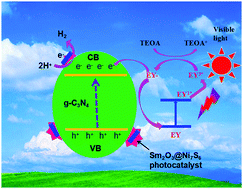当前位置:
X-MOL 学术
›
New J. Chem.
›
论文详情
Our official English website, www.x-mol.net, welcomes your feedback! (Note: you will need to create a separate account there.)
Rare earth element, Sm, modified graphite phase carbon nitride heterostructure for photocatalytic hydrogen production
New Journal of Chemistry ( IF 3.3 ) Pub Date : 2018-12-07 00:00:00 , DOI: 10.1039/c8nj05619f Lingjiao Li 1, 2, 3, 4 , Hai Yu 1, 2, 3, 4 , Jing Xu 1, 2, 3, 4, 5 , Sheng Zhao 1, 2, 3, 4 , Zeying Liu 1, 2, 3, 4 , Yanru Li 1, 2, 3, 4
New Journal of Chemistry ( IF 3.3 ) Pub Date : 2018-12-07 00:00:00 , DOI: 10.1039/c8nj05619f Lingjiao Li 1, 2, 3, 4 , Hai Yu 1, 2, 3, 4 , Jing Xu 1, 2, 3, 4, 5 , Sheng Zhao 1, 2, 3, 4 , Zeying Liu 1, 2, 3, 4 , Yanru Li 1, 2, 3, 4
Affiliation

|
Photocatalytic nanomaterials of rare earth metal modified graphitic carbon nitride (g-C3N4) were successfully prepared using a simple hydrothermal ion exchange method. As a high activity photocatalyst, the hydrogen evolution amount of the samarium(III) oxide@nickel sulfide-graphitic carbon nitride (Sm2O3@Ni7S6/g-C3N4) catalyst is nearly 3 mmol g−1 h−1 after visible light irradiation for 3 h, which was much more than the amount obtained using the Ni7S6/g-C3N4 catalyst. The characteristics of Sm2O3@Ni7S6/g-C3N4 were determined using scanning electron microscopy, transmission electron microscopy, X-ray diffraction, X-ray photoelectron spectroscopy, ultraviolet-visible spectroscopy (UV-vis), fluorescence spectra and so on. The results showed that the deposited Sm2O3@Ni7S6 was uniformly dispersed on the g-C3N4 sheet, and the Sm2O3@Ni7S6 was used as a cocatalyst to improve the electron transfer rate and hydrogen production rate, and reduce the compound rate of electrons and holes in the composite material. There was a strong synergy between Sm2O3@Ni7S6 and g-C3N4, which improved the photocatalytic performance. The UV-vis spectra showed that the absorption range of Sm2O3@Ni7S6/g-C3N4 was enlarged, and the forbidden band width was smaller. The Brunauer–Emmett–Teller results showed that Sm2O3@Ni7S6/g-C3N4 had a greater specific surface area and pore volume, which were beneficial for the adsorption of dye molecules and enhanced the photocatalytic activity. Therefore, rare earth metal samarium oxides might be a potential cocatalyst for the design of a new photocatalyst in the photocatalysis field.
中文翻译:

稀土元素Sm改性石墨相氮化碳异质结构用于光催化制氢
采用简单的水热离子交换法成功地制备了稀土金属改性石墨碳氮化物(gC 3 N 4)的光催化纳米材料。作为具有高活性的光催化剂,该钐的氢生成量(III),氧化镍@硫化物系石墨氮化碳(SM 2 ö 3 @Ni 7 š 6 / GC 3 Ñ 4)催化剂是近3毫摩尔克-1 ħ -可见光辐照3 h后返回图1中的结果,这远大于使用Ni 7 S 6 / gC 3 N 4获得的量催化剂。使用扫描电子显微镜,透射电子显微镜,X射线衍射,X射线光电子能谱,紫外可见光谱(UV-vis),荧光来确定Sm 2 O 3 @Ni 7 S 6 / gC 3 N 4的特性。光谱等。结果表明,沉积的Sm 2 O 3 @Ni 7 S 6均匀地分散在gC 3 N 4板上,而Sm 2 O 3 @Ni 7 S 6均匀地分散在gC 3 N 4板上。用作助催化剂可提高复合材料中的电子传输速率和产氢速率,并降低电子与空穴的复合速率。Sm 2 O 3 @Ni 7 S 6与gC 3 N 4之间具有很强的协同作用,从而提高了光催化性能。紫外可见光谱表明,Sm 2 O 3 @Ni 7 S 6 / gC 3 N 4的吸收范围扩大,禁带宽度减小。Brunauer–Emmett–Teller结果表明,Sm 2 O 3 @Ni 7S 6 / gC 3 N 4具有较大的比表面积和孔体积,有利于染料分子的吸附并增强了光催化活性。因此,稀土金属sa氧化物可能是光催化领域中新型光催化剂设计的潜在助催化剂。
更新日期:2018-12-07
中文翻译:

稀土元素Sm改性石墨相氮化碳异质结构用于光催化制氢
采用简单的水热离子交换法成功地制备了稀土金属改性石墨碳氮化物(gC 3 N 4)的光催化纳米材料。作为具有高活性的光催化剂,该钐的氢生成量(III),氧化镍@硫化物系石墨氮化碳(SM 2 ö 3 @Ni 7 š 6 / GC 3 Ñ 4)催化剂是近3毫摩尔克-1 ħ -可见光辐照3 h后返回图1中的结果,这远大于使用Ni 7 S 6 / gC 3 N 4获得的量催化剂。使用扫描电子显微镜,透射电子显微镜,X射线衍射,X射线光电子能谱,紫外可见光谱(UV-vis),荧光来确定Sm 2 O 3 @Ni 7 S 6 / gC 3 N 4的特性。光谱等。结果表明,沉积的Sm 2 O 3 @Ni 7 S 6均匀地分散在gC 3 N 4板上,而Sm 2 O 3 @Ni 7 S 6均匀地分散在gC 3 N 4板上。用作助催化剂可提高复合材料中的电子传输速率和产氢速率,并降低电子与空穴的复合速率。Sm 2 O 3 @Ni 7 S 6与gC 3 N 4之间具有很强的协同作用,从而提高了光催化性能。紫外可见光谱表明,Sm 2 O 3 @Ni 7 S 6 / gC 3 N 4的吸收范围扩大,禁带宽度减小。Brunauer–Emmett–Teller结果表明,Sm 2 O 3 @Ni 7S 6 / gC 3 N 4具有较大的比表面积和孔体积,有利于染料分子的吸附并增强了光催化活性。因此,稀土金属sa氧化物可能是光催化领域中新型光催化剂设计的潜在助催化剂。



























 京公网安备 11010802027423号
京公网安备 11010802027423号